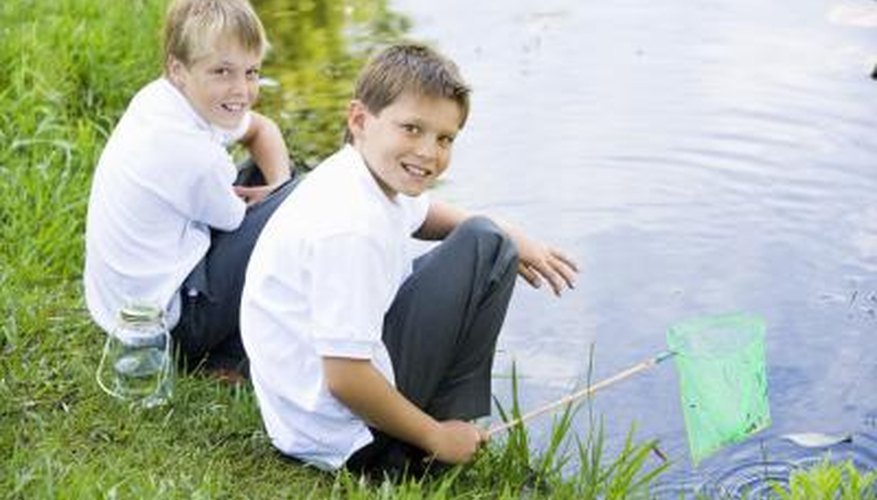A pond is home to many different types of animal species. If you look closely, you may be able to spot eggs from some of these creatures floating on or submerged in the pond water. If the embryo has started to develop and is visible in a clear egg, you may be able to determine what type of animal it will become. Otherwise, you may have to do a little sleuthing to figure out what kind of animal will hatch out of the egg.
Possible Suspects
Fish, insects, frogs, toads and even salamanders lay their eggs in or on pond water. Very small eggs floating on the water or stuck to an aquatic plant will probably belong to an insect. Frog and toad eggs will be larger than those of an insect and will usually be attached to one another with a jellylike substance. Fish eggs are usually small, sticky and are not laid in a clump. Salamanders or newt eggs will look like a large blob of jelly. Robyn's Pond Egg Identification Page (fishpondinfo.com) has some very helpful tips that can help you identify what species laid the eggs you have found.
- Fish, insects, frogs, toads and even salamanders lay their eggs in or on pond water.
- Salamanders or newt eggs will look like a large blob of jelly.
Types of Frogs and Toads
Many different types of frogs lay their eggs in ponds, including spring peepers, wood frogs and bullfrogs. Toads also lay their eggs in pond water. If it is late winter to early spring and you have found a small egg mass less than an inch in size, you probably have found spring peeper frog eggs. Listen for the parents nearby, making the loud peeping sound that gives them their name. Bullfrogs lay their eggs in large sheets during the late spring. Unlike the jelly mass of eggs that frogs lay, toad eggs will look like black beads strung on long ropes of jelly.
- Many different types of frogs lay their eggs in ponds, including spring peepers, wood frogs and bullfrogs.
- Unlike the jelly mass of eggs that frogs lay, toad eggs will look like black beads strung on long ropes of jelly.
Salamanders and Newts
Some types of salamanders and newts lay their eggs in water. The eggs are typically laid in a large jellylike clump that may be found resting at the bottom of a pond or attached to aquatic vegetation. Some newt and salamander egg masses look very similar to frog egg clumps. The biggest difference is that the frog eggs will typically float, while salamander eggs will sink. Salamander larvae bear a resemblance to tadpoles as well, but have visible external gills that set them apart.
- Some types of salamanders and newts lay their eggs in water.
- Salamander larvae bear a resemblance to tadpoles as well, but have visible external gills that set them apart.
Other Animals
If you have found small eggs that are either floating on the surface or attached to aquatic plants, you may have found insect eggs. Although many types of insect eggs are hard for a human to spot, the eggs of dragonflies are visible to the naked eye. Dragonflies lay small, white jellylike strings that have tiny brown eggs inside of them.
- If you have found small eggs that are either floating on the surface or attached to aquatic plants, you may have found insect eggs.
If you have found small, individual sticky round eggs submerged in water, you have probably found fish eggs.
